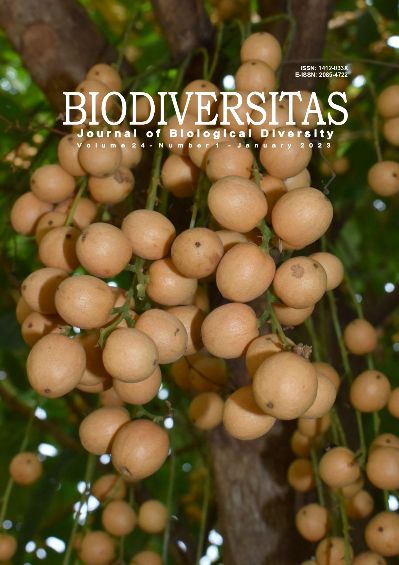Assessing the carrying capacity of mangroves as raw materials for culinary products: Case study in Serdang Bedagai, North Sumatra, Indonesia
##plugins.themes.bootstrap3.article.main##
Abstract
Abstract. Purwoko A, Susilowati A, Situmorang AI. 2023. Assessing the carrying capacity of mangroves as raw materials for culinary products: Case study in Serdang Bedagai, North Sumatra, Indonesia. Biodiversitas 24: 250-257. Many studies have focused on the ecological and socio-economic benefits of the mangrove ecosystem, yet limited information is available regarding the potential uses of non-timber products from mangroves for creative culinary products. This study aims to assess the production and carrying capacity of raw materials derived from mangrove vegetation to make processed food products using a case study from mangrove ecosystem in Kampung Nipah Mangrove Tourism Area, Sei Nagalawan Village, Perbaungan Sub-district, Serdang Bedagai District, North Sumatra Province, Indonesia. In doing so, we analyzed the species composition and abundance of mangrove vegetation to result in the production potential of raw materials used for culinary purposes. Ten mangrove species were recorded in the studied area with Acanthus ilicifolius, Rhizophora apiculata and Avicennia marina were the most important species at the seedling, sapling and tree level, respectively. The Kampung Nipah Mangrove Tourism Area utilizes three mangrove species as raw materials for food, namely A. marina, Soneratia caseolaris, and A. ilicifolius which are used as raw materials for making mangrove dodol (a sweet toffee), fruit syrup, and crackers, respectively. Based on the abundance of species used for mangrove culinary products, the abundance of A. marina and A. ilicifolius are highly available, while S. caseolaris is scarce. These results imply that the abundance of A. marina and A. ilicifolius is sufficient for dodol and crackers production, yet the abundance of S. caseolaris is not sufficient as raw material for syrup processing. Therefore, it is necessary to enrich the population S. caseolaris to support the production of mangrove syrup.
##plugins.themes.bootstrap3.article.details##
Most read articles by the same author(s)
- AGUS PURWOKO, SUTARNO SUTARNO, NITA ETIKAWATI, DNA polymorphism at locus-2 of growth hormone gene of Madura cattle , Biodiversitas Journal of Biological Diversity: Vol. 4 No. 1 (2003)
- SITI LATIFAH, MUHDI MUHDI, AGUS PURWOKO, ETIKA TANJUNG, Estimation of aboveground tree biomass Toona sureni and Coffea arabica in agroforestry system of Simalungun, North Sumatra, Indonesia , Biodiversitas Journal of Biological Diversity: Vol. 19 No. 2 (2018)
- AGUS PURWOKO, HELTIMALA TURNIP, WAHYU HARYATI MASER, The pattern of Etlingera elatior cultivation in agroforestry systems and its use as traditional medicines and food by local people of Kabanjahe, North Sumatra, Indonesia , Biodiversitas Journal of Biological Diversity: Vol. 20 No. 7 (2019)
- SUTARNO SUTARNO, ARIS JUNAIDI, AGUS PURWOKO, NEO INDRA LELANA, Identification and characterisation of the polymorphic growth hormone gene of the Bali cattle, the Madura cattle and Ongole cattle , Biodiversitas Journal of Biological Diversity: Vol. 3 No. 1 (2002)

